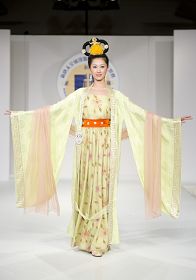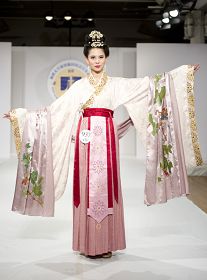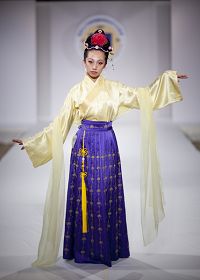Journey to the East: Handcrafted Fashions From Ancient Dynasties: Third International Han Couture Design Competition Showcases Traditional Chinese Costumes (Photos)
(Clearwisdom.net) NEW YORK--Young men smiling with a modest demeanor, elegant ladies walking with delicate footsteps--a unique show featuring dozens of exquisitely handcrafted Chinese costumes was put on the catwalk at the Metropolitan Pavilion in the fashion capital of New York on Oct. 16.
The costumes, called Hanfu, are traditional clothes of the Chinese and were designed by professionals from around the world who competed in New Tang Dynasty TV's third Global Han Couture Design Competition.
Some of the costumes suggested the lucid streams along the southern banks of the Yangtze River, some were reminders of the glorious royal court of the capital's Forbidden City, and some resembled the lightness and elegance of fairies shown in the mural art of Buddhist temples.
The handcrafted pieces, each telling an ancient story, brought Chinese history alive.
Taking a closer look, even the inner garments featured hand-embroidered patterns that were previously drawn repeatedly as sketches by the contestants. When it comes to hanfu, not even one inch from head to toe is left plain.
As audience member Christian Bernard recalled, the show was a "visual symphony of design, colors, fabrics, and jewelry."
Each of the costumes showcased clothing from the Tang (618-907), the Song (960-1279), and the Ming (1368-1644) Dynasty--three important periods when the Han ruled China over neighboring minority groups and their culture flourished.
While the main styles remain similar, each dynasty incorporated its own variations. The Tang Dynasty was the most prosperous time in terms of culture and economy, so its people dressed in bright colors and prestigious styles. Women of the court liked long, wide and loose sleeves, sometimes long enough to trail on the ground when they walked.
Clothing of the following Song Dynasty inherited most of the late Tang styles. Yet the people praised preservation and added a more scholarly aspect to the clothing as Confucian studies flourished during the dynasty. Thus light and elegant colors were favored.
The Ming Dynasty's first emperor personally directed the nation in reviving hanfu after China was previously ruled by the Mongolians, who influenced the way the Chinese dressed. Clothes makers in the Ming Dynasty added more details to the designs. Handcrafting was well-developed, and more jewelry was attached to the garments and worn as accessories.
Usually people consider qipao, the ethnic costume of the Manchurians, to be Chinese because the Manchurians ruled throughout the last dynasty, named the Qing Dynasty (1644-1912). Actually, qipao is Manchurian and not Chinese.
Thus the authenticity of the style was one of the most important judging criteria in the competition, along with color combination and fabric selection. In order to learn about how people dressed in ancient times, the contestants had to research historical books and artworks.
The Chinese call their country "the prime nation for garments and hats and the land of ceremony and proprieties." There is a different design for every occasion, and each design has a traditional philosophy behind it.
For example, the seams of clothes should be sewn straight, in the middle of the back, since straightness imparts the meaning of righteousness as a person who is not bent or bowed.
All cuts should be made round, as that alludes to harmony. Some dresses consisted of 12 pieces, symbolizing the 12 months in a year.
There is no use of buttons in hanfu. Rather, short strings are attached at the side and one needs to tie knots to fasten the garment. The knots should always be tied at the right side, which is the yang side according to Daoism. Tying at the left side, or the yin side, indicates that one's family member or friend just passed away.
This use of short strings and knots makes hanfu very comfortable to wear as it can be adjusted to each person's body. Therefore, hanfu is less made-to-fit than modern clothing. Instead, it is the structure of the clothing that shapes the figure.
"The ancient clothing is not revealing, and gives less attention to the body. It doesn't mean that the design is not eye-catching. Rather, people thought one's mind shapes the demeanor," said Fanghong Ye, a contestant from New York.
Harmonious Designs
Harmony and completion are key elements of hanfu design.
"The combination of main and [secondary] fabrics and colors of different garments all played their roles in making the whole design look harmonious. I used clothes of natural color tones in all of my three entries to the competition," said Winna Lam, the Gold Award winner of this year's competition.
"Even the texture of the thread used for embroidering is important. Every bit needs careful consideration. If one small part goes wrong, the whole costume will be ruined," said Lam. Her winning costume consisted of a total of 12 pieces.
Each of the contestants is not only an experienced designer but also an excellent painter, handcrafter, and historian.
"The Promise in Heaven" by Winna Lam from the US
"Meeting Joyfully" by Tou-Ying Kao from Taiwan
"The Prosperous Times" by Ya-Chi, Chan from Taiwan
"The Garments of Rainbow in My House" by Shui-Chin Wu and Pao-Hsui Chen from Taiwan
"The Garments of Rainbow in My House" by Shui-Chin Wu and Pao-Hsui Chen from Taiwan
"Harmony" by Li-Mei Tang Lin and Shou-Chun Ding from Taiwan
"The Rain Garments of the Prosperous Time" by Biqiong Gong from the US
Sometimes, finding the right color or fabric to make a pattern can be a challenge. Lam and other contestants mixed and matched paints and drew on the garments to make the perfect look, so not even a tiny bit was allowed to go wrong.
The designers themselves talked about the care they put into making the clothing and the feelings they have about the importance of this opportunity to share Han design with a wide public.
"I had to do it very carefully, since it's not possible to fix if I make a mistake," said Lam.
"I think the public will be astonished by the beauty of Chinese clothing--the grace, richness, and colors of it. I see it as a must for us to revive such a precious form of art left by our ancestors," said Outstanding Award winner Ying Chen from New York.
"I always wanted to present the beauty of Chinese clothing as to inspire other designers to put more efforts in reviving our ethnic fashion. One day, people will be walking on the streets wearing traditional clothes on certain occasions," said Silver Award winner Tou-Ying Kao from Taiwan.
"The traditional Chinese clothing reflects both the beauty of the design and the elegance and decorum of the ancient people."
The Winners:
Gold Winner
"The Promise in Heaven" by Winna Lam from the US
Silver Winner
"Meeting Joyfully" by Tou-Ying Kao from Taiwan
Bronze Winner
"The Prosperous Times" by Ya-Chi, Chan from Taiwan
Special Award for Outstanding Men's Formal Outfit
"The Garments of Rainbow in My House" by Shui-Chin Wu and Pao-Hsui Chen from Taiwan
Special Award for Outstanding Women's Formal Outfit
"The Garments of Rainbow in My House" by Shui-Chin Wu and Pao-Hsui Chen from Taiwan
Special Award for Outstanding Crafts
"Harmony" by Li-Mei Tang Lin and Shou-Chun Ding from Taiwan
Special Award for Outstanding Combination
"The Rain Garments of the Prosperous Time" by Biqiong Gong from the US






